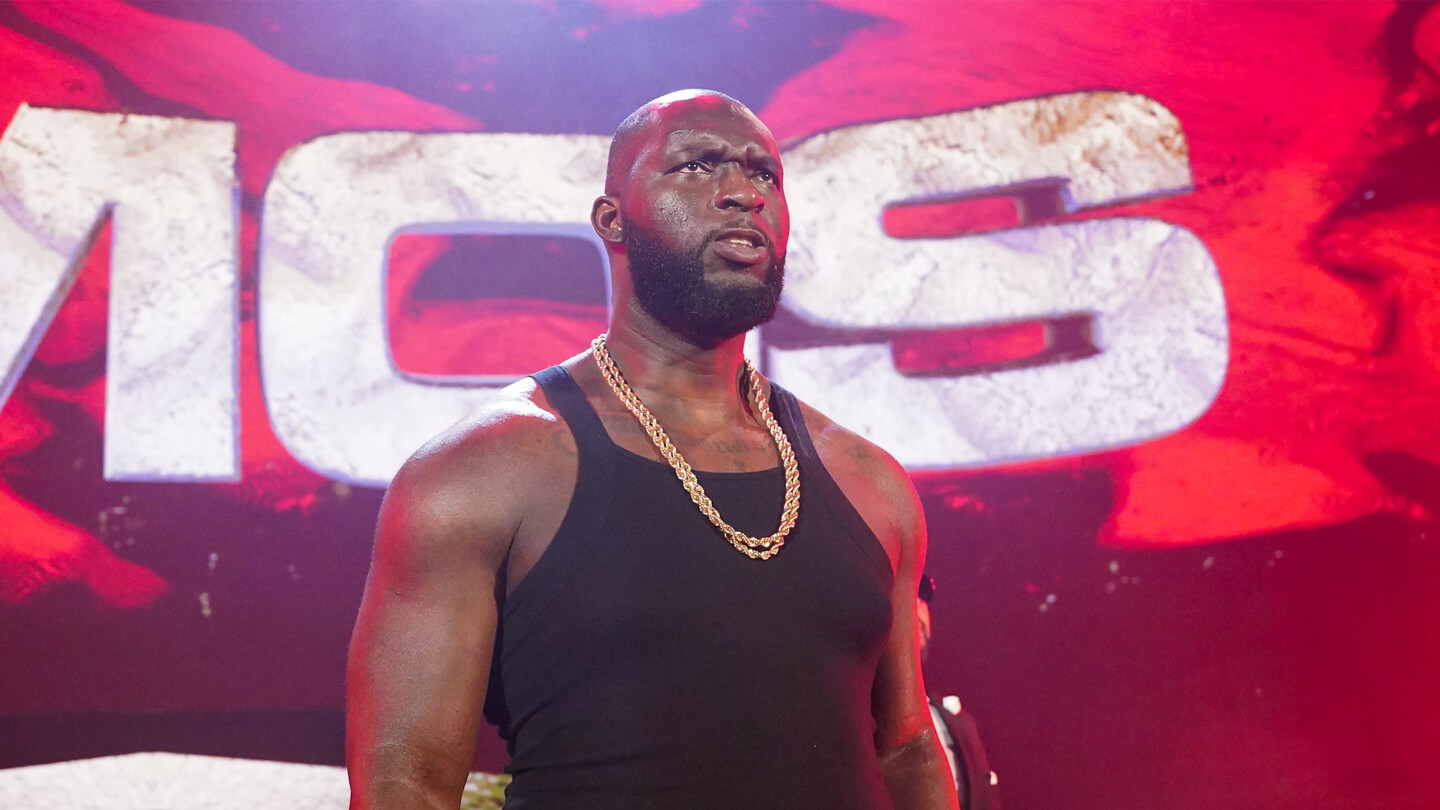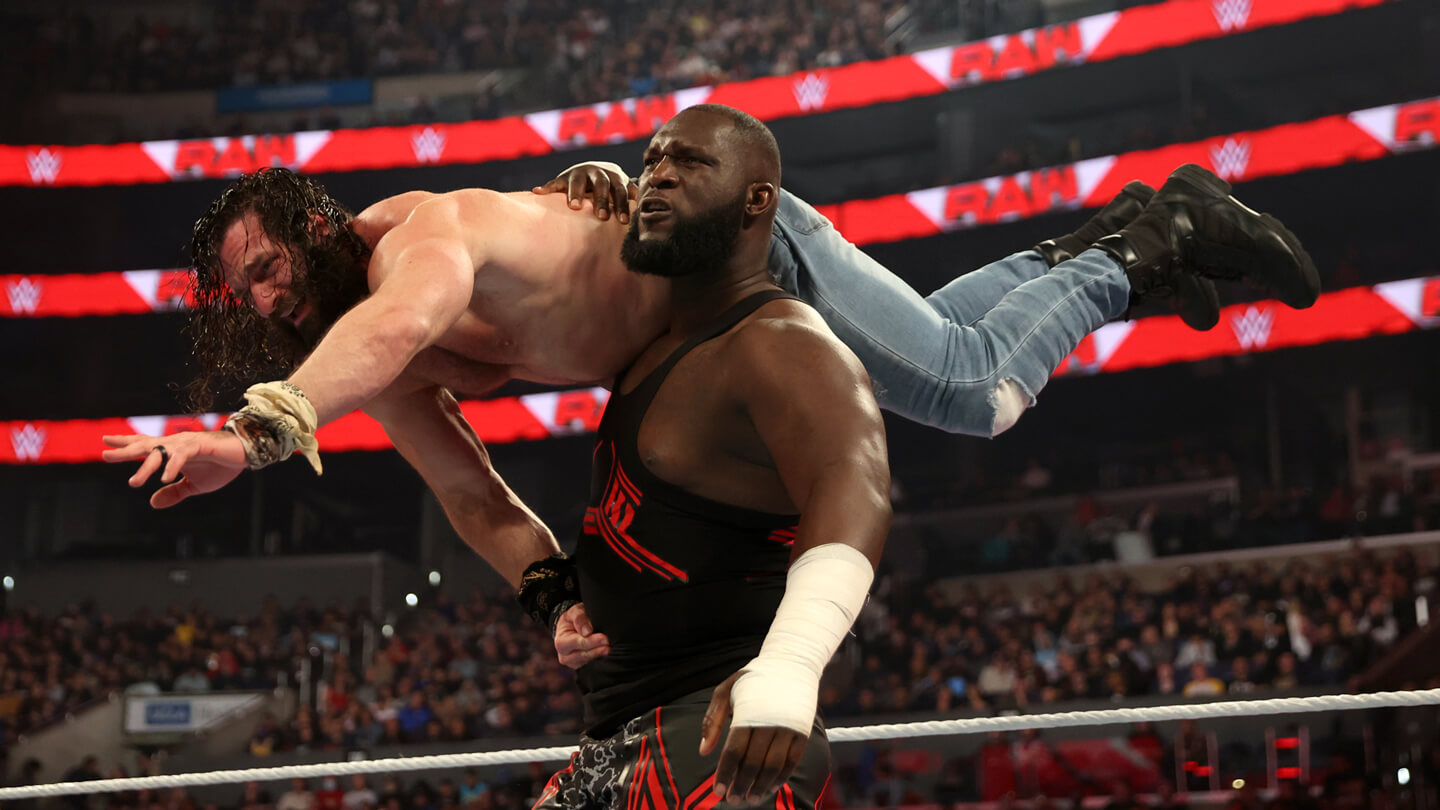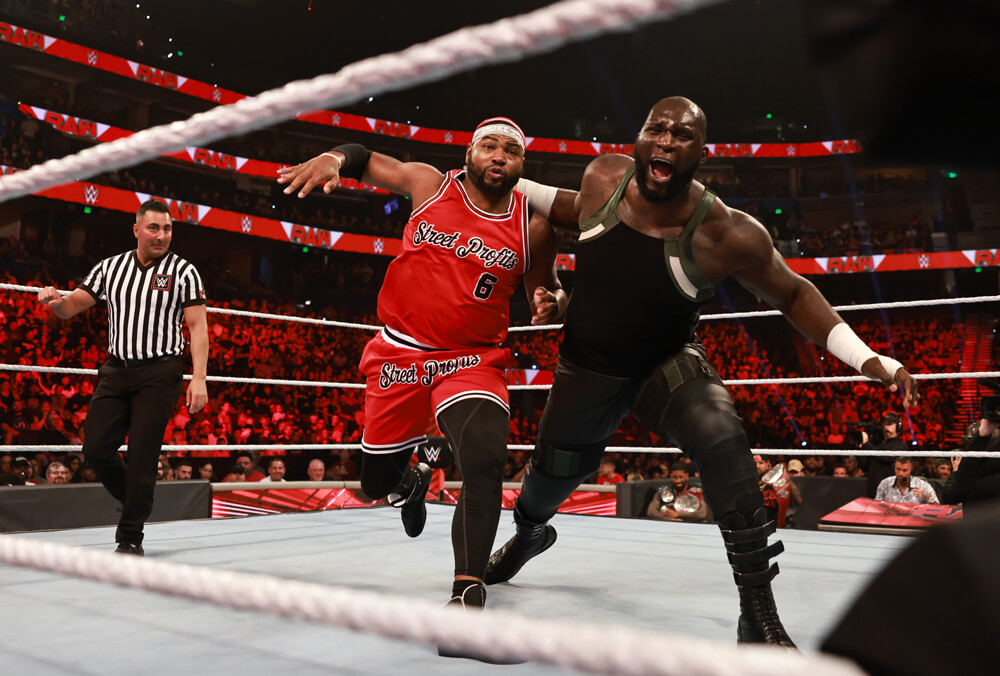NOT-SO-GENTLE GIANT

W WE superstar Omos doesn’t look like your typical babyface.
With a seven-foot-three, 400-plus-pound frame and a stern resting face, Omos (Jordan Omogbehin), brow furrowed, cuts the figure of a typical WWE villain. He was recruited as an obvious “big bad,” a Goliath destined to serve as foil to any number of underdog good guys. He is a spiritual descendant of Andre the Giant, The Great Khali, Big Show, and Kane, men so physically imposing their mere presence creates peril for opponents and automatic table stakes for fans.
Billed as “The Nigerian Giant,” his WWE career to date has placed him in exactly that role. From bodyguard for Shane McMahon’s short-lived Raw Underground to tag-team partner and heavy for A.J. Styles, Omos’s introduction to the WWE universe has been exactly what you’d expect. And it’s been successful, with marquee matches and a run as a tag-team champion.
As he’s struck out on his own as a singles wrestler, though, a strange thing has happened. The online wrestling community has put a spotlight on a more lovable side of Jordan Omogbehin, celebrating his artwork and his sense of humour, sharing his “Giant Problems” social media posts, and inundating him and his new wife with well-wishes on their wedding day. These “Omosapiens,” as they call themselves, have seen in Omogbehin one of their own, one who just happens to be enormous enough to wreak havoc in a WWE ring.
The response hasn’t changed his on-screen presentation, for now, but this massive, intimidating, vicious heel has developed an earnest and wholesome fanbase. And in an era where wrestling fans are as aware of the person as they are the character, Omogbehin’s popularity threatens to usurp the unlikability of Omos. A swell of online support and pockets of cheers for the bad guy from live crowds begs an unexpected question: Could WWE’s next big villain be a massive babyface in waiting?
“From a psychology standpoint, it can be very challenging for someone who’s seven-foot-three, muscles, and huge and intimidating, to get sympathy,” Omos says. “Heels don’t inspire people, only babyfaces do. And for me, that’s going to be the challenge: How can this big, giant person inspire people? Because there’s no relatability to someone who’s seven-foot-three … the moment where you see me with somebody smaller than me, the brain says, ‘I want the little guy to kick the big guy’s ass.’”
That’s usually true. Then again, very little about Omogbehin’s journey from shy Nigerian teen to top NCAA basketball prospect to WWE superstar has been usual.

O mogbehin playing a character in front of thousands of fans live and millions on TV is not something those who knew him in his youth envisioned. A shy, quiet kid growing up in Lagos, he was more content to be alone drawing and painting, watching anime, and occasionally watching WCW with his grandmother than he was to be outside socializing.
It was basketball that first brought him out of his shell and, eventually, took him to the United States. After shooting up to six-foot-seven around age 12, Omogbehin was recruited for a basketball camp run by Masai Ujiri’s Giants of Africa program.
“I had just started playing basketball that summer, and I just kind of bum-rushed into the camp,” Omogbehin says. “I was a very tall kid that couldn’t walk and chew bubblegum.”
Raw was par for the course for a still-emerging Giants of Africa program in 2005. Ujiri remembers Omogbehin as “just learning the sport, learning the game,” and Omogbehin’s early camp work focused on developing a baseline skill level and understanding. From there, his size and commitment to improving took over, turning a raw kid into an interesting prospect.
Through the connections made at those camps, Omogbehin got on the radar of prep schools in the United States. A few years after his first camp, Ujiri and Giants of Africa co-founder Godwin Owinje helped him find a fit at Atlantic Shores Christian School in Virginia and transition to the United States, where he’d be away from his family for an extended period for the first time.
“Without them, there’s no coming,” Omogbehin says. “What Masai has done with Giants of Africa is primarily the reason why I’m here in WWE. Without him having that for us young Nigerian kids, without Giants of Africa, there is no Omos.”
Immersed in basketball (and sneaker) culture, Omogbehin set goals for himself. He wanted to become a top-50 prospect in his college class, earn a scholarship to Georgetown University, and eventually make the NBA. He picked up advanced aspects of the game quickly, and coaches found the right buttons to push to bring the competitive fire out of the otherwise quiet teenager.
On his way to those goals, though, he tore his ACL, costing him his senior year of high school in 2010 and slowing his momentum as a collegiate prospect. Instead of Georgetown, Omogbehin landed at the University of South Florida. As he was rehabilitating, he tore that same ACL again. He admits, in retrospect, this is when he first considered what his path might be if basketball didn’t work out. In the moment, though, he pushed forward. There were bigger obstacles to come.
Following a game with USF, once Omogbehin had returned to play, a doctor in attendance raised a concern to the team. Based on Omogbehin’s particular size and facial structure, the doctor worried Omogbehin had an undiagnosed brain tumor. It was a bold assessment from afar. It was also a correct one, and one that may have saved Omogbehin from more serious complications down the line.
The months that followed included surgery and a period as a self-described “guinea pig” while doctors tried to figure out the right mix of medications and hormone treatments. As endocrinologists studied Omogbehin, he was also diagnosed with acromegaly (which he sums up as “you grow wide and big”) and gigantism (“you grow tall”). The rare combination of conditions made for a lot of trial-and-error with specialists, and, he says, some of “the darkest moments of my life.”
“It broke me down for a little bit,” he says. “It was tough, because in that moment you’re alone. And, you know, imagine that type of information being put in an 18-, 19-year-old kid. The ACL injuries I could handle, I could recover from, but this was completely far from what I had imagined. And for me, at that point in time, it was a lot for me to take on.”
The impact was far-reaching. Omogbehin dealt with a great deal of uncertainty about his health and future, and the feeling he was failing to accomplish the basketball goals his family had sacrificed for him to achieve. He also had to contend with altered hormone levels in a hyper-competitive sports environment.
“I was all over the place, man,” he says. “Even when I got a hold of it [medically], I was all over the place emotionally. I got severely depressed. It was bad.”
Basketball reality set in, too. He’d played just 159 minutes over three years at South Florida, had two ACL repairs on his record, and was now dealing with multiple major medical conditions. At the same time, the NBA was transitioning away from the type of centre he’d envisioned himself as and worked to become, away from “the Greg Monroes and the Roy Hibberts” who spent years in college and emerged as system-oriented bigs.
Omogbehin eventually transferred to Morgan State for a season, then to Division II King’s University to complete a master’s in business. During that time, the wheels were turning on what could come next.

D oug Martin knew how to get the competitive fire out of Omogbehin on the AAU circuit. Now a G League coach in the Los Angeles Clippers’ organization, Martin would prod at Omogbehin and tell him basketball wasn’t for him, and that they were going to instead ship him to Connecticut to wrestle for WWE.
“I used to get infuriated,” Omogbehin remembers. “It was just something he said to get me to play hard. And I used to get so mad and I would go and score 20 points and say, ‘See, it’s there!’”
The seeds that were planted tongue-in-cheek eventually bore fruit. When Omogbehin was at South Florida, he’d accompanied football player Antoine Pozniak to a meeting with Steve Keirn, who ran a WWE developmental territory, Florida Championship Wrestling, at the time. Keirn quickly became enamoured but even though Omogbehin says “the sales pitch was great,” he initially pocketed the idea for when he was officially done with basketball.
That time came a few years later, when Omogbehin’s college eligibility was up and a deal to play in China fell through due to immigration issues. A friend reminded him of his flirtation with wrestling, and with no other ideas front of mind, Omogbehin thought it was worth revisiting.
On a whim, he sent a casual email to Canyon Ceman, then WWE’s senior director of talent development. Ceman asked Omogbehin to send some recent pictures, then asked him to call as soon as he could. That was on a Sunday. They wanted him in for a tryout Monday morning.
Omogbehin had no idea what to expect when he and his then-girlfriend (now wife) made the drive from Tampa to Orlando to WWE’s Performance Center.
“From the first time I hit the ropes, I said, ‘Ohhh, this is fun,’” he remembers. “I just felt so liberated. I never felt this in basketball.”
WWE was as enthralled as Omogbehin, telling him he had a job whenever he wanted one. The next day, he attended a taping of NXT, where he met Paul “Triple H” Levesque and Shawn Michaels, a pair of WWE Hall of Famers and key figures in the company’s developmental system.
Levesque did the soft sell, telling Omogbehin to chase basketball if he needed to and to let them know if and when he wanted to try wrestling. Quietly, though, Levesque texted Ceman during the show, asking if Omogbehin was taking to the experience.
“He shows me the text, and I’m like, “Yup, I’m doing this!’” Omogbehin says. “And that is how this whole life started.”
Omogbehin called Coach Martin — eventually the best man in his wedding — and reminded him of the threat he used to make to him as a teenager.
“I said, ‘You’re not gonna believe what happened,’” Omogbehin says. “He was just, like, cracking up on the phone. He always said it. I just never imagined me being a wrestler, but once I got there, wrestling felt more home than basketball.”

T he wrestling education of Omos progressed quickly.
Seeing a potential star, WWE made sure he was surrounded with training and resources, including legendary big men like The Undertaker, Mark Henry, and Kevin Nash to learn from. A self-described sponge, Omogbehin still spends downtime watching older footage to learn the business and pick up anything he can from stars of the past.
WWE responded to his aptitude by pushing him, if carefully. First, he was behind a mask as a giant ninja as part of a series of semi-serious backstage segments. (“I’m one of the Hidden Village in Naruto,” he said to himself to get hyped up to play that part, referring to a Japanese manga series about a ninja.) A supporting role alongside an established character like McMahon helped him loosen up and learn to play off his counterparts on camera. Teaming with Styles put him in big matches where his physical duties were limited alongside one of the greatest in-ring performers of the generation. Early as a solo wrestler, he was managed by MVP, one of the best character-workers of recent vintage.
Through the early years, Omos’s character has been pretty straightforward. “Bad guy, a couple suits, let’s get it done,” he says. As he’s improved, WWE has given him more opportunity to show what he can do, putting him in marquee programs with main event stars like Bobby Lashley, Brock Lesnar, and Seth Rollins. He’s developed into a menacing presence those who knew a teenage Omogbehin chuckle at.
“There’s a big difference from that youthful kid,” Ujiri says by phone, between a trip to South Africa for Basketball Without Borders and this August’s 20th anniversary Giants of Africa event in Rwanda. “He’s just a really lovable, big kid, and that was it. It’s a big contrast, but very, very interesting.”
Omogbehin is trying to get Ujiri out to a WWE event, which Ujiri says he’d love to do. In the meantime, Ujiri understands the potential for Omogbehin to inspire the next generation of African athletes beyond just basketball.
“These kids need a lot of opportunity, and some of them might fall into basketball and follow that path. There’s a huge ecosystem, you know, that if you don’t play basketball, you could do something within sports where you realize your dreams, like Jordan,” Ujiri says.
A character like Omos inspiring people is not the usual formula you see in wrestling, or generally in storytelling. As Omogbehin laid out, it’s natural to root for a physical underdog. Still, a tide turned around the time of his match with Rollins. It was Omos’s best performance to date from an in-ring quality standpoint, his physical development and understanding of wrestling psychology reaching a level where he seemed ready for a true solo run. That coincided with Omogbehin becoming more open sharing his life on social media, from his art to his love of anime to his recent wedding. Initially starting as a joke on Cameo, the movement of Omosapiens has become larger and louder in wrestling communities on Twitter and Reddit.
“It’s been interesting to see, and see them enjoy, you know, me as Omos and also Jordan the person, and everything I do and what I’m interested in outside of wrestling,” Omogbehin says. “it’s been a trip, man. It’s been fun to watch.”
He still has his hesitations about his potential as a fan-favourite on-screen. The timing and execution have to be perfect, and Omogbehin worries about his character as sympathetic failing to be believable. He may ultimately prefer to keep his inspirational personal story, from Nigeria through medical hardship to WWE, purely off-screen. “But I have thought about it quite a bit,” he says, a slow chuckle from deep in his chest emerging behind a wide smile.
If his life in wrestling continues to unfold as it has so far, he may not have a choice. He made his debut and a WrestleMania appearance in the same city, Tampa, where he spent so much time thinking he was failing. That “poetic justice,” in his words, doesn’t go unappreciated by the audience. Nor does his affability on social media, in interviews, or when he breaks character to make a young fan smile at a live show.
A babyface arc for Omos almost writes itself: From a young, quiet, artistic kid watching WCW with his grandma in Nigeria, to the United States through the Giants of Africa basketball program, through a series of medical scares, and to the largest wrestling stage in the world.
“This is one of the best decisions I’ve ever made in my life. This is fun,” Omogbehin says. “To wake up every day, go to work, play a character on TV that either people love or hate, people are so invested in the character you present on TV. What we do, it’s so amazing, man. And to know that some kid out there watching the show, they’re going to grow up watching me on TV. I could have never pictured this life.”
Little about Omogbehin’s life has played out the way he pictured, so no path can be ruled out from here. Even one as an unlikely fan favourite.